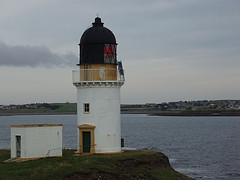Vlieland is not a large island; the main road stretches for all of 7 miles (11 km) from the northeastern cape to the Army Camp in the south. Beyond that, a large sand plain (Vliehors) stretches for another 4 miles in the direction of the neighbouring island of Texel. This Saturday, we set off for a walk the length of the island, starting from the Ankerplaats bungalow southwest towards the second highest dune in the island, the Kooispleklid, at 100 feet in height. It is an easy walk through undulating, grass-covered dunes, with many bushes. Beyond the Kooispleklid, the path leads to the Lange Paal campsite. Lange Paal is Dutch for Long Pole. The National Water Management Agency had a reference pole there at one time, and due to rot had to add another pole on top of it. It is also the start of a 3½ mile round walk, signed with coloured markerposts.
Lange Paal sits next to a small forestry plantation; there are several of these plantations in Vlieland. The largest encircles the village of Oost Vlieland; there are four others, Lange Paal, Nieuwe Kooi, Oude Kooi and Bomenland. Apart from Oude Kooi, today's walk will show us all of them. The round walk veers into the dunes, then dives into the plantation of Nieuwe Kooi, which surrounds the pond in which ducks would have been trapped in years gone by. Nowadays, it is one of those tranquil spots you find in abundance in this island. We had lunch by its shores, plagued by nothing worse than a female duck begging for crumbs. The walk continued on the eastern (Wadden Sea) shores of the island to the last forest, Bomenland. This means Land of Trees in Dutch, and is the oldest plantation, dating back to 1906. It is noticeable for a small monument to a crashed WW2 bomber and a lovely viewpoint. On entering the forest along the main road, you see a small grave marker, where sailors lie buried who died of infectious diseases in years gone by. The poem on the board is well known in our family, but no longer recited aloud following the death of our mother in 2008.
Hier rust het stof uit vroeger dagen - Here rests the dust from days gone by
Verborgen in een houten kist - Hidden in a wooden chest
Wilt eerbied voor deez' rustplaats dragen - Give honour to this place of rest
Daar zulks plicht en menslijk is - As such is a duty to humanity
Beyond Bomenland stands the Posthuys restaurant, which used to be a mailstage in the days that the mails for Vlieland came from Amsterdam by relay through Texel. Following the crossing of the Eyerlandse Gat narrows between Vlieland and Texel, the mailrider would make his way over the sandblown waste of the Vliehors to find sanctuary at the Posthuys.
There is these days only one town in Vlieland, Oost Vlieland (East Vlieland). It is a prosperous, very touristy place. Until the 18th century, there was also a West Vlieland. It now lies 4 miles west of the Vliehors, under several fathoms of water. Yellow bricks from its houses still wash up on the strands of Vlieland. It is strangely ominous sign that the coat of arms for the village of West Vlieland is a barren tree.
Our walk was ended by walking back to the cottage along the North Sea strand, a distance of about 5 miles.
Subscribe to:
Post Comments (Atom)

No comments:
Post a Comment